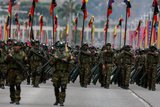Tekever unveils AR3 for maritime surveillance
The AR3 VTOL UAV. (Photo: Tekever)
Portugal-based Tekever claimed on 26 April to have launched the smallest VTOL UAV with integrated synthetic aperture radar (SAR) capabilities, after unveiling its new AR3 platform for maritime surveillance at the AUVSI Xponential exhibition in Orlando, Florida.
The hot-swappable AR3 features the GAMASAR radar, which covers more than 20,000 square nautical miles per wide-area surveillance mission.
‘With the new upgrade, the AR3 becomes the most operationally flexible UAS in the market, and the smallest UAS to boast a high performance, dual side looking Synthetic Aperture Radar,’ Tekever claimed in a statement.
CEO Ricardo Mendes said: ‘Users no longer have to choose between having pure fixed-wing assets for longer-endurance missions, or fixed-wing VTOL assets for more challenging deployment conditions.’
Related Equipment in Defence Insight
More from Uncrewed Vehicles
-
![What's next for the Pentagon after the Replicator programme?]()
What's next for the Pentagon after the Replicator programme?
Although the Replicator initiative has made several accomplishments, there are still multiple gaps to plug across the US Department of Defense (DoD) and its services.
-
![Cummings Aerospace showcases Hellhound loitering munition designed for US Army’s LASSO programme (video)]()
Cummings Aerospace showcases Hellhound loitering munition designed for US Army’s LASSO programme (video)
Cummings Aerospace presented its turbojet-powered Hellhound loitering munition at SOF Week 2025, offering a man-portable solution aligned with the US Army’s LASSO requirements.
-
![SOF Week 2025: PDW unveils attritable FPV drone for SOF operations at scale]()
SOF Week 2025: PDW unveils attritable FPV drone for SOF operations at scale
PDW has revealed its Attritable Multirotor First Person View drone at SOF Week 2025, offering special operations forces a low-cost, rapidly deployable platform for strike and ISR missions, inspired by battlefield lessons from Ukraine.
-
![SOF Week 2025: Teledyne FLIR white paper provides guidance on reusable loitering munitions]()
SOF Week 2025: Teledyne FLIR white paper provides guidance on reusable loitering munitions
Teledyne FLIR is highlighting the emerging requirements for 'recoverable and re-usable' loitering munitions across the contemporary operating environment during this week’s SOF Week conference in Tampa, Florida.
-
![SOF Week 2025: Kraken Technology group debuts K3 Scout USV in North America]()
SOF Week 2025: Kraken Technology group debuts K3 Scout USV in North America
High-performance maritime industry player Kraken Technology Group, based in the UK, has used the SOF Week conference in Tampa, Florida this week to debut its K3 Scout uncrewed surface vessel (USV) to the North American market.
-
![Palladyne AI and Red Cat to demonstrate capabilities for autonomous drone swarms to the US military]()
Palladyne AI and Red Cat to demonstrate capabilities for autonomous drone swarms to the US military
Red Cat and Palladyne AI recently conducted a cross-platform collaborative flight involving three diverse heterogeneous drones.

























